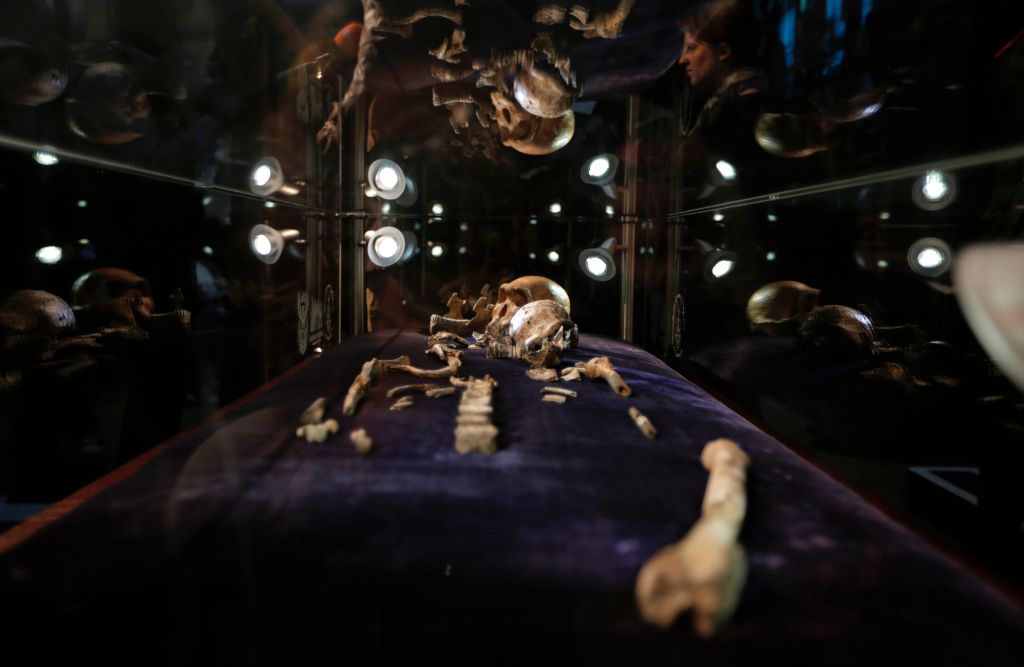Scientists claim ancient human relatives buried their dead, sparking evolution debate


Researchers believe they have discovered possible burial sites dug by a smaller-brained human ancestor over 100,000 years before the oldest known human burials, a claim that "would revise the story of our evolution," The Washington Post reported.
The scientists uncovered the possible sites while studying the Rising Star cave system northwest of Johannesburg, South Africa, where they also found drawings of triangles and squares, as well as crosshatchings, carved into the limestone. The team attributed their findings to the Homo naledi species, whose brains were three times smaller than early humans and Neanderthals. Scientists believe Homo naledi remains were first uncovered in the Rising Star system in 2015.
That a small-brained hominin partook in such humanlike rituals is quite a significant discovery, as it suggests bigger brains are not necessarily needed for more sophisticated behavior, Lee Berger, a paleoanthropologist at the University of Witwatersrand in Johannesburg and lead scientist of the project, told The New York Times. "That would mean not only are humans not unique in the development of symbolic practices, but may not have even invented such behaviors," he said in a statement.
The Week
Escape your echo chamber. Get the facts behind the news, plus analysis from multiple perspectives.

Sign up for The Week's Free Newsletters
From our morning news briefing to a weekly Good News Newsletter, get the best of The Week delivered directly to your inbox.
From our morning news briefing to a weekly Good News Newsletter, get the best of The Week delivered directly to your inbox.
Announced at the Richard Leakey Memorial Conference at Stony Brook University in New York and in three online papers, the research team's claims have "triggered the kind of fierce debate that has followed H. naledi since its discovery made headlines in 2015," the Post wrote. Some experts who weren't a part of the study are skeptical that the evidence proves the species was intentionally burying its dead. Others aren't convinced the engravings are thousands of years old. But if the study's claims are valid, they would "overthrow the dogma that burial of the dead is the sole province of our species, Homo sapiens," the Post added.
Michael Petraglia, the director of the Australian Research Center for Human Evolution, told the Times he is "highly optimistic that [Homo naledi] have burials, but the jury is still out." He said he wanted to see a more detailed analysis of the sediment at the sites before drawing any conclusions, but "[t]he problem is that they're ahead of the science."
A free daily email with the biggest news stories of the day – and the best features from TheWeek.com
Theara Coleman has worked as a staff writer at The Week since September 2022. She frequently writes about technology, education, literature and general news. She was previously a contributing writer and assistant editor at Honeysuckle Magazine, where she covered racial politics and cannabis industry news.
-
 Political cartoons for January 4
Political cartoons for January 4Cartoons Sunday's political cartoons include a resolution to learn a new language, and new names in Hades and on battleships
-
 The ultimate films of 2025 by genre
The ultimate films of 2025 by genreThe Week Recommends From comedies to thrillers, documentaries to animations, 2025 featured some unforgettable film moments
-
 Political cartoons for January 3
Political cartoons for January 3Cartoons Saturday's political cartoons include citizen journalists, self-reflective AI, and Donald Trump's transparency
-
 Blue Origin launches Mars probes in NASA debut
Blue Origin launches Mars probes in NASA debutSpeed Read The New Glenn rocket is carrying small twin spacecraft toward Mars as part of NASA’s Escapade mission
-
 Dinosaurs were thriving before asteroid, study finds
Dinosaurs were thriving before asteroid, study findsSpeed Read The dinosaurs would not have gone extinct if not for the asteroid
-
 SpaceX breaks Starship losing streak in 10th test
SpaceX breaks Starship losing streak in 10th testspeed read The Starship rocket's test flight was largely successful, deploying eight dummy satellites during its hour in space
-
 Rabbits with 'horns' sighted across Colorado
Rabbits with 'horns' sighted across Coloradospeed read These creatures are infected with the 'mostly harmless' Shope papilloma virus
-
 Lithium shows promise in Alzheimer's study
Lithium shows promise in Alzheimer's studySpeed Read Potential new treatments could use small amounts of the common metal
-
 Scientists discover cause of massive sea star die-off
Scientists discover cause of massive sea star die-offSpeed Read A bacteria related to cholera has been found responsible for the deaths of more than 5 billion sea stars
-
 'Thriving' ecosystem found 30,000 feet undersea
'Thriving' ecosystem found 30,000 feet underseaSpeed Read Researchers discovered communities of creatures living in frigid, pitch-black waters under high pressure
-
 New York plans first nuclear plant in 36 years
New York plans first nuclear plant in 36 yearsSpeed Read The plant, to be constructed somewhere in upstate New York, will produce enough energy to power a million homes
